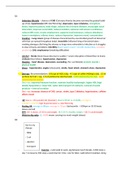Q1:
- Sedentary lifestyle – chances of CHD (Coronary Arteries become narrowed by gradual build-
up of fat), hypertension (BP≥140/90mmHg), depression, type 2 diabetes, strengthens
bones, improves posture, body shape, reduces risk of chronic diseases, encourages social
interaction, improves social skills, reduces isolation, enhances self-esteem +confidence,
reduces NHS costs, creates employment, supports local businesses, reduces attendance
issues in workplace, relieves stress, reduces depression, improves mood, concentration
- Smoking – Lung cancer (group of disease characterised by uncontrolled growth of abnormal
cells that can spread throughout body), bronchitis (inflames lining of bronchial tubes –
smoking damages cilia lining the airways so lungs more vulnerable to infection as it struggles
to clear irritants and debris), infertility (lower sperm count + erectile dysfunction, ovulation
problems), CHD, emphysema (breathing difficulties)
-
- Alcohol – Stroke (brain tissue dies due to sudden + severe disruption of blood flow to brain),
cirrhosis (liver failure), hypertension, depression
- Sleeping – heart disease, depression, overeating, (for +ve lifestyle) protects mental +
physical health
- Stress – hypertension, angina (chest pain), stroke, heart attack, stomach ulcers, depression
-
- Diet gov. Recommendations: 6-8 cups of H2O a day, 4-5 cups of coffee (400mg) a day, 1/3 of
portions be fruit + veg, 1/3 of portions be starchy foods, 2,500 calories/day for men, 2,000
calories/day for women
- Diet +ves: improved immune function, maintain healthy bodyweight, higher HDL (high
density lipoprotein) + lower LDL, water aids transport of nutrients, removal of waste
products + internal secretion
- Diet –ves: Increases chances of CHD, cancer, stroke, type 2 diabetes, hypertension, caffeine
affects mood
-
- BP: low is < 90 (systolic)/60 (diastolic), ideal is 90/60 ≤x ≤120/80, pre high is
120/80<x<140/90, high (hypertension) is ≥140/90mmHg
- Resting HR: average is 68bpm, average is 72bpm (tachycardia - >100bpm or 20-30 beats
above normal)
- BMI: 30+ is obese, 25-30 is overweight, 18.5-24.9 is healthy weight, <18.5 is underweight
- Waist-to-hip ratio: ≥1, ≥0.85 means carrying too much weight (obese)
Q2:
- Exercise - cycle/walk to work, jog between lunch breaks, 3,000 steps a
day + increase by 500 steps a week (barrier: time, cost for bike), walk before breakfast, doing
, housework (more vigorously), gardening, stairs instead lift, play new sport, join a club,
10,000 steps a day
- Exercise benefits: strengthens bones, improves posture, body shape, reduces risk of chronic
diseases, encourages social interaction, improves social skills, reduces isolation, enhances
self-esteem +confidence, reduces NHS costs, creates employment, supports local businesses,
reduces attendance issues in workplace, relieves stress, reduces depression, improves mood,
concentration, decreased resting HR, BMI, wait-to-hip ratio, BP, release endorphins that
reduces stress + promotes restful sleep, (opposite to Q1),
-
- Stress – breathing techniques, exercise, meditation, time management (barrier: time/none),
assertiveness training, goal setting, positive self-talk, relaxation, herbal remedies, changes to
work-life balance (barrier: none)
- No stress benefits – decreased BP, chances of hypertension + depression, (opposite to Q1)
-
- Sleep – 7-9 hours, reducing stress helps, reduces chances of heart disease + overeating +
protects mental + physical health, (opposite to Q1) (barrier: time)
-
- Smoking – NHS smoking helpline/services (must be willing to quit), nicotine replacement
therapy, quit kit support packs (barrier: none/saves money), acupuncture
- No smoke benefits; decreased resting HR + BP, (opposite to downsides from Q1)
-
- Alcohol – self-help groups (must recognise that there’s a problem), counselling,
acupuncture, hypnosis
- No alcohol benefits – decreased BP, reduced chances of cirrhosis, hypertension (opposite to
downsides from Q1)
Q3:
- Gov, recommendation: 2,500 calories for men, 2,000 calories for women
- -ve (consume more calories than burnt), +ve (consume less calories than burnt) energy
balance, RMR (resting metabolic rate influenced by age, composition of body + sex), DT
(energy expended for digestion, absorption, transport + storage of food), PA, AT (energy
expenditure that comes from environmental or physiological stresses that may require
shivering as a response, or stress that causes anxiety or fidgeting)
- Simple carbs - fast source of energy + easily digested + absorbed, found in fruit (/juices),
milk)
- Complex carbs – broken down more slowly + releases energy over longer periods, should be
largest % of total carb intake, found in (wholemeal/wholegrain are higher nutritional value +
fibre) bread, rice pasta, potatoes, beans
- Carb gov. Recommendation: 45-70% total consumed calories from carbs
-
- Saturated fats – fatty acids, mainly from animal sources, along with cholesterol (linked to
build-up of fatty substances on artery walls), found in meat, eggs, full dairy products, butter,
hard margarines
- Unsaturated fats – less likely to build up fatty acids on artery walls, found in nuts, olive oil,
soft margarine, oily fish, sunflower oil
- Fat (provides heat insulation, mechanical cushioning + buoyancy) gov. Recommendation:
30g/day for men, 20g/day for women
-




